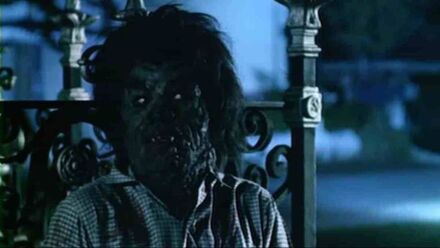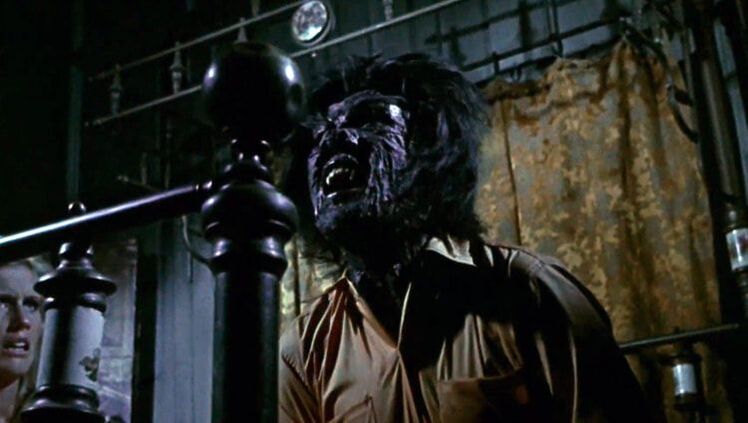 Welcome to a weekly series in which Doris V. Sutherland takes readers on a trip through the history of werewolf cinema... ...Beast of the Yellow Night (1971) opens in 1946 at an unspecified Southeast Asian country. Joseph Langdon (John Ashley), a former US soldier who defected to the Japanese and has lived a life of murder and theft since the war, is on his last legs. Pursued by soldiers and trapped in a forest with only poisonous fruit for food, his only hope is to call upon dark powers. A demonic entity obligingly offers him a means of survival: after he dies, his spirit can inhabit the body of a recently-dead man—so long as he continues his evil deeds. Decades pass and Langdon enters his latest host, the corpse of a successful businessman who was killed and disfigured in an industrial accident; the resurrection process also heals the man’s face, causing him to look like Langdon did in life. There are more changes in store, however. As Langdon continues to lose his remaining vestiges of humanity and become an embodiment of evil, he periodically transforms into a hairy, clawed brute whose appetites now include cannibalism… The sixties saw werewolf cinema spread to include Europe and Latin America, and this process continued into the seventies: with Beast of the Yellow Night, a US-Philippines co-production from writer-director Eddie Romero, we have an early Asian addition to the genre. Granted, the term “werewolf” is never used to describe Langdon’s alter ego, but it may as well have been; this shaggy beast is a lycanthrope in all but name. And a remarkably brutal lycanthrope he is, as well; in one scene ripping out a victim’s organ and messily devouring it—a trick clearly influenced by the rising tide of zombie gut-munchers. Indeed, Langdon scores a possible fatality even before he transforms, as his resurrection gives a nearby doctor a heart attack. Langdon’s Hyde-side is not the only supernatural menace afoot in the film, as Vic Diaz co-stars as his Mephistopheles-like mentor. Presumably Satan (although his exact identity is never confirmed) this character adapts his guise to fit his surroundings: he wears tribal get-up when he first appears in the forest; materialises in a suit and tie when walking about town; and manifests in a police uniform when visiting Langdon in jail. Every bit the urban fantasy devil, then, and there is some good on-screen chemistry as he tries to goad Langdon still further along the path of evil. For all of its lurid aesthetic, Beast of the Yellow Night is clearly trying to be something more than just a rampaging-monster romp: it wants to give its audience something to think about in regards to the nature of good and evil. Consider the character of Sabasas (Andres Centenera), a blind man who befriends Langdon. Initially, this appears to be a mere imitation of the scene in Bride of Frankenstein where the monster enters the home of a blind man, but as the subplot unfolds we learn that Sabasas is a former bandit who has tried to mend his life. Langdon, on his way to becoming a monster but still holding the potential to regain his humanity, is surrounded by figures representing temptation and redemption. Another character in this morality play is Julia (Mary Wilcox), the wife of Langdon—or rather, the widow of the man whose body Langdon is possessing. The film takes the time to build a tender love story here, with the possibility of Julia tugging Langdon onto the straight and narrow. Even the sex scenes—while clearly added primarily as an excuse to put Mary Wilcox’s breasts on screen—aim for a degree of aesthetic value, with dreamy semi-transparent figures superimposed over the onscreen action. This mixture of trash and substance is the stuff of any truly great exploitation film, but the trouble is that Beast of the Yellow Night doesn’t quite get the balance right. The film places too much faith in its rather stiff supporting cast, and ends up tangled in its duller plot threads (nothing brings a monster movie grinding to a halt quite like dialogue-heavy scenes in a police station). The plot really could have done with more graphic gut-munching to keep things lively. Beast of the Yellow Night ends up as one of those frustrating films that falls between two stools, too lurid to work as a character-led drama and too sedate to satisfy as an all-out horror film. But one thing it can hardly be accused of, however, is hewing overly close to genre convention. As werewolf films go, this is a decidedly offbeat outing. By Doris V. Sutherland
0 Comments
Leave a Reply. |
Archives
March 2023
|

 RSS Feed
RSS Feed